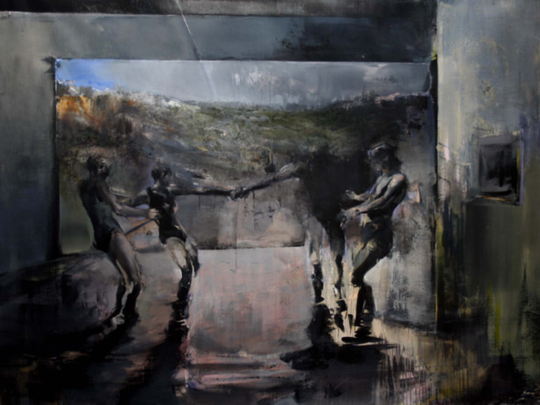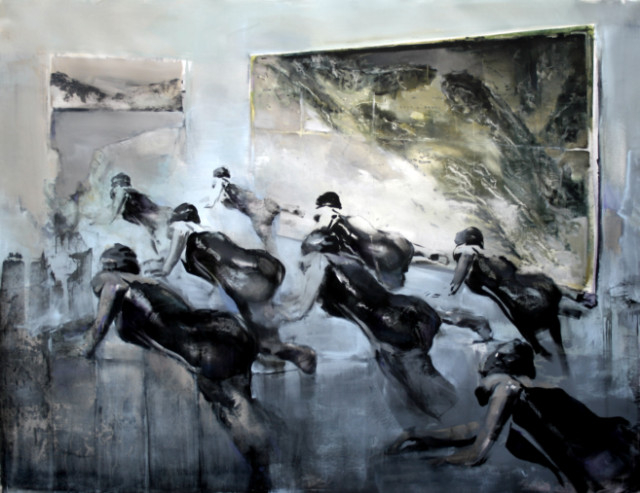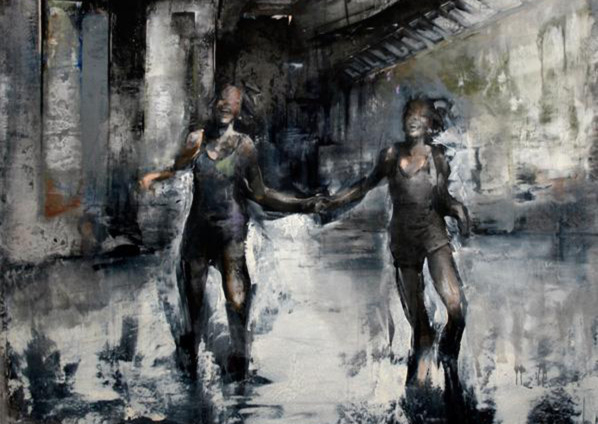
Zsolt Bodoni’s work investigates the tools of power under various regimes through the prism of his own childhood experiences. The artist was born in Romania and later moved to Hungary. His paintings are based on his own memories of growing up under dictatorial regimes along with images related to other such regimes in history. By revisiting the past, the artist tries to understand how various ideologies and systems of control originated, and contemplates the long-term impact of social and political indoctrination. His work challenges long-held belief systems and questions notions of political, social and religious conformity. It provokes viewers to think about personal and collective preconceptions and mindsets that remain even after regimes fall. In his latest exhibition titled, “King Give Us Soldiers”, Bodoni focuses on the role of physical education and even childhood games as tools of power that inculcate in young minds a mentality of group conformity and discipline.
The show’s title comes from a painting depicting children playing a popular game of that name. In this game the children stand in two rows facing each other and holding hands. One by one the children from each row must try to break through the other row. If they succeed they take a prisoner back to their team, and if they fail they are held captive by the other team. The painting and the title of the show draw attention to the fact that this seemingly innocent and fun activity is actually a child’s first participation in an act of war.
“The main theme of this show is education, especially physical education in schools. I have done in-depth research on this subject, which includes sports and games and I am specifically concerned with the fine line that exists between these elements and the act of war,” Bodoni says.
Most of the paintings in the show feature people involved in group activities such as swimming, physical exercise, games, and events that encourage group conformity such as the May Day celebrations. The faceless groups highlight the undertones in our systems of education that can lead to the loss of individual identities and personalities.
The connection with the artist’s own childhood and the invisible power games that people are exposed to early in life is established through several canvases depicting innocent, smiling children playing together. The people in Bodoni’s paintings seem to be happy and energetic. But his dark palette, the grim, grey, industrial surroundings and the hazy look of the paintings suggest a different mood. The artist has used many layers of paint on each canvas and has deliberately not concealed the lower layers to create visual depth and to give viewers a sense of peeping into the past by peeling off the layers of time.
“These images are based on Thirties’ and Forties’ photographs of the Third Reich. And seeing them in the context of that tragic period in human history completely changes their meaning. I used a palette that helped me recreate the faded look of the old black-and-white images and also added some splashes of colour to mimic the stains on the photographs. The characters on my canvases seem to be smiling in the moment, but the fact that they come from a document of a tragic history changes our perspective of them. I want to convey that we are often unaware of the power games happening around us, and it is only in retrospect that we can see things for what they are. I am referencing history to understand my own past and also how history has shaped our present world,” Bodoni says.
The artist has used various techniques to express his feelings. In a painting titled “Ants”, he has used multiple images of a single swimmer to highlight the loss of individuality through activities that promote conformity. His painting of May Day celebrations, a group activity popular in both communist and Third Reich regimes, draws on his own childhood memories. “Traditionally, May Day used to be a celebration of spring. But it changed completely in the communist era. As children we were forced to participate in these orchestrated celebrations and act like puppets, doing exactly as instructed,” he says.
In some of the paintings, the artist has used warships and horses, saddles and gas masks as symbols of the tools of power used by human beings. “These images are based on actual scenes from the First World War. ‘The Boat’ is the most static piece in the show and is like a still-life painting using the tools of power. The horses were used extensively in this war and it is common knowledge that more horses than men died in the First World War. The saddles and gas masks emphasise the fact that these animals were there for the purpose of serving the whims of human beings and were mere tools in their quest for power,” he says.
An interesting element in the paintings is the background. Amid the stark, grey, industrial spaces where the people are shown exercising, you can often see colourful landscapes on the walls. These have been inspired by postcards and photographs of Eastern Europe after the First World War and Second World War. And it is not clear whether what you are seeing is a painting or projection on the wall or the view from a window. Through these pictures within pictures, the artist once again invites viewers to question their perceptions and to reflect on the past to understand the present.
Jyoti Kalsi is an arts enthusiast based in Dubai.
The exhibition will run at Green Art Gallery until March 3.





